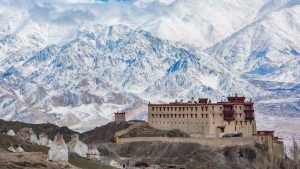Nestled amidst the serene hills of the Darjeeling district and adorned with vibrant flora, Lamahatta is an enchanting hamlet, beckoning you to embark on a rejuvenating escape from the bustle of daily life. With its breathtaking views of the Eastern Himalayas, lush forest of pine and dhupi, and tranquil atmosphere, Lamahatta is a haven for nature lovers and honeymooners. At the heart of this picturesque setting Lamahatta Eco Park stands as a prime attraction, that invites nature enthusiasts to embark on a unique and sustainable journey.
In the following sections, we will delve into a comprehensive description of Lamahatta eco-tourism. Discover everything you need to know before planning a tour to Lamahatta, including essential details on how to visit, the best time to go, accommodation options, recommended local cuisines, nearby markets, and top attractions to explore. Stay informed and make the most of your visit to Lamahatta by knowing all the details beforehand.
Lamahatta Eco-tourism: A Journey of Development
The name “Lamahatta” derives from the fusion of two words, “Lama” (referring to Buddhist monks) and “hatta” (meaning hut), symbolizing the heritage of the Buddhist monks. Nestled approximately 23 km away from Darjeeling, at an altitude of 5700 ft, Lamahatta was once an offbeat destination, frequented only by a handful of nature enthusiasts who sought solace in its serene surroundings.
![Lamahatta Eco Park: A Nature Lover's Paradise [Know Everything before visit] 2 Lamahatta Eco Park - top view of the garden](https://travelentice.com/wp-content/uploads/2023/06/Lamahatta-Eco-Park-top-view-of-the-garden.jpg)
Lamahatta eco-tourism officially and commercially initiated in 2012 under the observation of honorable chief minister of West Bengal of that time. It was during a spontaneous visit by the honorable CM (WB) at that time that the enchanting beauty of Lamahatta captivated her. The lush roadside forests of pine and dhupi, panoramic views of the Eastern Himalayas, the aerial perspective of the Rangeet River, and the misty ambiance of the Lamahatta village left a lasting impression, prompting her to envision and develop a sustainable eco-tourism facility in Lamahatta.
Subsequently, the collaborative efforts of local villagers and the forest protection team, supported by the West Bengal Tourism Development Authority, led to the establishment of Lamahatta Eco park, a testament to the community’s dedication towards preserving and showcasing the natural wonders of the region.
You may find interesting: Gurudongmar Lake at Sikkim – The Sacred Spirit of North-East
Lamahatta Eco Park: The prime attraction in Lamahatta
Lamahatta Eco Park is conveniently located alongside the main road. On one side of the road, you’ll find a cluster of homestays, restaurants, and shops, creating a lively atmosphere. On the other side, Lamahatta Eco park unfolds across the sloping hill, offering a serene and natural setting for visitors to explore and enjoy.
![Lamahatta Eco Park: A Nature Lover's Paradise [Know Everything before visit] 3 Into the mist at Lamahatta Eco Park](https://travelentice.com/wp-content/uploads/2023/06/Into-the-mist-at-Lamahatta-Eco-Park-1024x763.jpg)
Most part of Lamahatta village offers extensive mountain and valley views, but the primary attraction for tourists is Lamahatta Eco Park. Indeed, it’s a nature lover’s paradise nestled amidst the dense forest of pine and dhupi, where you can immerse yourself in the lush greenery, vibrant flora, and tranquil ambiance of this eco-friendly haven.
Unlike commercial parks, Lamahatta Eco park has been thoughtfully developed to preserve the true essence of untouched nature. While the lower part of the park features manmade decorations with various flower plants, the upper part is embraced by a natural pine forest. A stone-built hiking path provides access to the mesmerizing beauty of the Lamahatta pine forest and leads you to the sacred lake.
Related Article: Simanadara – A Hidden Heaven Where Mountains Meet the Valley
Embark on an exhilarating hiking adventure to the sacred pond (Jore Pokhari) atop Lamahatta Eco Park
![Lamahatta Eco Park: A Nature Lover's Paradise [Know Everything before visit] 4 Sacred pond at Lamahatta Eco Park](https://travelentice.com/wp-content/uploads/2023/06/Sacred-pond-at-Lamahatta-Eco-Park-1024x576.jpg)
Once you enter the park, prepare for an approximately 1 km uphill hike to reach the sacred pond. Guided by stone-made stair steps through the dense Pine and Dhupi forest, the route is not very steep, and there are plenty of benches for resting along the way. So, even if you lack hiking experience, there’s no need to worry.
As you trek through picturesque trails surrounded by dense pine forests, you’ll encounter breathtaking vistas and a harmonious blend of scents from the floating clouds. Upon reaching the summit, you’ll be greeted by the serene and mystical beauty of the sacred lake, where the clouds and forest converge in silence.
Take a moment to soak in the tranquility, marvel at the pristine waters, feel the ethereal presence of the clouds, and respect the silence. This peaceful ambiance will envelop you in a heavenly experience, so revel in it for as long as possible before you land back to the polluted earth.
Cautionary Note:
- Please note that this hiking trail may pose challenges for older individuals.
- Individuals with knee problems are advised to avoid this hike.
- People who encounter breathing problem should also avoid it.
- Taking shortcuts are strongly discouraged as they can be slippery and potentially dangerous.
- Take extra caution when descending as the moist atmosphere makes the stair steps slippery.
How to Reach Lamahatta Eco Park
The accessibility to Lamahatta depends on your starting point or last staying destination. If you’re planning a 1-2 night stay in Lamahatta village and starting your journey from NPJ or Bagdogra Airport, you’ll find plenty of rented car or shared cabs available. It takes approximately 2.5 hours to reach Lamahatta from NPJ (67 km) and 3 hours from Bagdogra Airport (76 km).
- Nearest Railway station: New Jalpaiguri
- Nearest Airport: Bagdogra Airport
Lamahatta Eco Park is located along the Darjeeling-Kalimpong road. If you’re traveling along this route to your next destination, you can plan a 2-3 hour stop at Lamahatta to enjoy the surroundings. Rental cars are readily available from either of these places.
If your final destination is a nearby offbeat location like Tinchuley, Peshok, or Dawaipani, it is advisable to contact the homestay owner to arrange transportation for you. They can help organize a car for your convenience.
- Distance of Lamahatta Eco Park from Darjeeling: 23 km (1.5 h)
- Distance of Lamahatta Eco Park from Kalimpong: 31 km (1.5 h)
- Distance of Lamahatta Eco Park from Kurseong: 37 km (1.6 h)
- Distance of Lamahatta Eco Park from Takdah: 11 km (30 min)
- Distance of Lamahatta Eco Park from Tinchuley: 8 km (25 min)
- Distance of Lamahatta Eco Park from Peshok: 7 km (20 min)
When to Visit Lamahatta
Lamahatta is a year-round destination, but it is recommended to avoid the monsoon season due to the possibility of landslides in hilly areas that may affect travel.
The best time to visit Lamahatta is from late February to early May and from October to early December when the weather is pleasant and favorable for outdoor activities.
![Lamahatta Eco Park: A Nature Lover's Paradise [Know Everything before visit] 5 Resting land on the hiking path at Lamahatta Eco Park](https://travelentice.com/wp-content/uploads/2023/06/Resting-land-on-the-hiking-path-at-Lamahatta-Eco-Park.jpg)
During mid-winter (December-February), the temperatures can be extremely cold, offering a thrilling experience for those who enjoy the chilly climate of the eastern Himalayas. If you’re fortunate, you might even witness snowfall during this period, adding an extra touch of delight to your visit.
Accommodation near Lamahatta Eco Park
If you’re planning a 1-2 night stay in Lamahatta, your best option would be to choose from the local homestays available. Luxury resorts are not common in and around Lamahatta, and there’s a good reason for that.
The eco-tourism development in Lamahatta is designed to align with the principles of preserving ecological balance and protecting environmental biodiversity, ensuring minimal disruption to the natural surroundings. The local community actively participates in the tourism development, creating sustainable economic opportunities while maintaining a harmonious coexistence with the environment.
The growth of local homestays is a significant part of Lamahatta’s eco-tourism, supported by the government, with strict regulations in place to prevent any unwanted constructions. This approach benefits the environment, the local community, and the visitors alike.
Explore the list of Lamahatta homestays HERE.
Note: On clear days, Lamahatta offers a stunning view of the entire range of Mt. Kanchenjunga. If you’re planning a 1-2 night stay in Lamahatta, it is recommended to book a mountain-facing homestay to enjoy this breathtaking sight.
If you’re planning a 2-3 hour stop at Lamahatta Eco Park without an overnight stay, there are nearby destinations where you can choose to stay. Tinchuley, Dawaipani, and Peshok are some of the closest places to Lamahatta, offering great accommodation options for your visit; most of these homestays provide accommodation along with four meals a day included in the package at affordable cost.
- Explore the list of homestays in Tinchuley
- Explore the list of Homestays in Dawaipani
- A recommended homestay in Peshok
Food in Lamahatta
Just opposite the entrance of Lamahatta Eco Park, you’ll find a few tea and food stalls where you can stop by for a refreshing cup of tea or some snacks. Momo and noodles are popular snacks that you can enjoy throughout North Bengal or Sikkim.
As you hike to the top of Lamahatta hill, there is a couple run a temporary stall offering tea, coffee, and noodles. After a long hike, you might feel hungry or the cold weather may entice you to warm up with a hot beverage. Don’t hesitate to indulge in their offerings, as they work hard all day and deserve the support. Coffee is priced at Rs. 30/- and noodles at Rs. 50/-.
![Lamahatta Eco Park: A Nature Lover's Paradise [Know Everything before visit] 6 Tea stall atop Lamahatta Eco Park](https://travelentice.com/wp-content/uploads/2023/06/Tea-stall-atop-Lamahatta-Eco-Park.jpg)
Other places to visit near Lamahatta
Check the following list of places that are easily accessible from Lamahatta.
Lamahatta Monastery
Located just 1.5 km away from Lamahatta Eco Park, the Lamahatta Monastery is over 500 years old. It’s a short 20-minute walk from Lamahatta, but if you have a car, you can also reach there easily. Immerse yourself in the serene atmosphere and explore the rich cultural heritage of the monastery.
Gumbadara Viewpoint
This viewpoint offers a stunning 270-degree panoramic view of the majestic mountain range. On one side, you can witness the awe-inspiring Mt. Kanchenjunga, while on the other side, the entire Sikkim range unfolds before your eyes. The picturesque valley view from this Gumbadara Viewpoint is simply breathtaking.
Peshok Tea Garden
Situated a few steps downhill from the Gumbadara Viewpoint, the Peshok Tea Garden provides a perfect backdrop for capturing beautiful photos amidst the lush greenery. Take a leisurely stroll through the tea garden, appreciate the scenic surroundings, and learn about the art of tea cultivation.
Lovers Meet Viewpoint
At this viewpoint, you can witness the aerial view of the enchanting confluence of two rivers. The Rangit River and Teesta River merge here, creating a mesmerizing sight. Capture the scenic beauty and enjoy the tranquility of this spot.
Rangli Rangliot Tea Garden
Located near Takdah, the Rangli Rangliot Tea Garden is another picturesque tea estate worth visiting. Spend a serene evening in this serene place, surrounded by rolling tea plants, and savor the breathtaking view of the sunset.
Takdah Orchid Center (not well maintained), Tinchuley Monastery, Dawaipani, Bara Mangwa orange garden (seasonal).
Explore these nearby attractions during your trip to Lamahatta and immerse yourself in the natural beauty and cultural richness of the region.
Must read if you love trekking: Towards Sandakphu – The Untold Way to Reconnect with Yourself!
Wrapping up
Lamahatta Eco Park stands as a testament to the harmonious coexistence of nature and responsible tourism. With its undisturbed ecological balance and preservation of environmental biodiversity, the park offers a serene haven for nature enthusiasts. Additionally, the active involvement of the local community in the tourism development ensures sustainable livelihoods while maintaining the park’s pristine beauty.
Undoubtfully, Lamahatta Eco Park is a true gem, inviting visitors to reconnect with nature, appreciate its wonders, and leave with a deep sense of tranquility and environmental stewardship. If you are traveling across North side of West Bengal, don’t miss this place.
Dr. Suvankar Das is a scientific advisor by profession, associated with a CRO organization. He pursued his doctoral degree in Chemistry in 2015. Later, he worked as a postdoctoral researcher & scientist in a couple of institutes/companies.
Besides his scientific journey, Dr. Das is also a passionate traveler and travel blogger. He loves to share all his travel experiences with other travelers so that everyone can enjoy hassle-free holidays with their own tour plans.
He believes, the most beautiful thing in this world is the WORLD itself. so there is no way to live like a clock; rather live it like a compass!

![Lamahatta Eco Park: A Nature Lover's Paradise [Know Everything before visit] 1 You are currently viewing Lamahatta Eco Park: A Nature Lover’s Paradise [Know Everything before visit]](https://travelentice.com/wp-content/uploads/2023/06/Lamahatta-Eco-Park-Sun-and-cloud.jpg)





